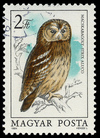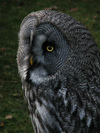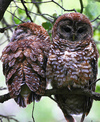Genus Strix
Tawny Owl - This nocturnal bird of prey hunts mainly rodents, usually by dropping from a perch to seize its prey, which it swallows whole; in more urban areas its diet includes a higher proportion of birds. Vision and hearing adaptations and silent flight aid its night hunting. The Tawny is capable of catching smaller owls, but is itself vulnerable to the Eagle Owl or Northern Goshawk. Red Foxes are an important cause of mortality in newly fledged young.
Hume's Owl - This species is a part of the larger grouping of owls known as typical owls, Strigidae, which contains most species of owl. The other grouping is the barn owls, Tytonidae.
Chaco owl - The Chaco Owl is an owl which inhabits dry chaco woodland in southern Bolivia, western Paraguay and northern Argentina.
Fulvous Owl - The Fulvous Owl , or Guatemala Barred Owl is a bold member of the cloud forests of Central America. Its habitat is limited to the high mountain ranges and the previously mentioned cloud forests of Guatemala, Honduras, and El Salvador. It inhabits elevations from 3900 to 10000 feet and is fairly common within its range. Although it is primarily nocturnal it is also occasionally seen in the mornings and afternoons. This rather friendly owl responds well to imitations of its call which sounds like woo-who-who-who.
Strix huhula - The Black-banded Owl is a species of owl in the Strigidae family. It is found in Argentina, Bolivia, Brazil, Colombia, Ecuador, French Guiana, Guyana, Paraguay, Peru, Suriname, and Venezuela. Its natural habitats are subtropical or tropical moist lowland forests, subtropical or tropical swamps, and subtropical or tropical moist montanes.
Rusty-barred Owl - They are medium-sized owls, 33 to 38 centimetres long, and weighing 285 to 340 grams . Their body and breast are rust-coloured, and they have a brown barring, hence their common name. They have dark eyes set in a rusty coloured heads. They also have a pale buff barring their upper parts.
Brown Wood Owl - The Brown Wood Owl is medium large , with upperparts uniformly dark brown, with faint white spotting on the shoulders. The underparts are buff with brown streaking. The facial disc is brown or rufous, edged with white and without concentric barring, and the eyes are dark brown. There is a white neckband. The sexes are similar.
Great Grey Owl - Adults have a big, rounded head with a grey face and yellow eyes with darker circles around them. The underparts are light with dark streaks; the upper parts are grey with pale bars. This owl does not have ear tufts and has the largest facial disc of any raptor.
Black-and-white Owl - Its natural habitats are subtropical or tropical dry forests, subtropical or tropical moist lowland forests, and subtropical or tropical moist montane forests.
Spotted Owl - This owl has a length of 43 cm , a wingspan of 114 cm , and a weight of around 600 g . Its eggs are a little over 2 inches long, and are white and smooth with a slightly grainy texture. The female sits on the eggs and cares for the young, while the male provides food for them. Juvenile Spotted Owls have an average survival rate of 11%, with an average birth rate of .58 owls per pair.
Mottled Wood Owl - The Mottled Wood Owl Strix ocellata is a species of medium sized owl found in South Asia. They are found in gardens and thin deciduous forests adjacent to dry thorn forests or agro environments. They are easily detected by their distinctive eerie laughing call of Chu hua-aa during the dusk and dawn, with a quaver in the second note. Usually found in pairs while roosting.
Rufous-legged Owl - http://www.owls.org/Species/strix/rufous_legged_owl.htm
Spotted Wood Owl - The Spotted Wood-owl is an owl of the earless owl genus, Strix. Its range is strangely disjunct; it occurs in many regions surrounding Borneo, but not on that island itself.
Ural Owl - The Ural Owl is smaller than the Great Grey Owl, and much larger than the Tawny Owl, which it superficially resembles. Distinguishing features apart from the size are the pale, buffish grey-brown plumage, with copious dark brown streaking on the back, back of the head and underparts. It has a round head with plain buffish-grey facial discs, orange-yellow bill and small black eyes. The tail is long and wedge-shaped, with dark barring on the uppertail, and the wings are rounded. Flight is direct and purposeful, recalling that of the Common Buzzard. Sexes are similar, with no seasonal variation. Size: 50–59 cm; Wingspan: Male 115 cm, female 125 cm; Weight: Male 540-730 g, female 720-1200 g.
Hoot Owl - The Barred Owl is a large typical owl. It goes by many other names, including eight hooter, rain owl, wood owl, and striped owl, but is probably known best as the hoot owl.
Mottled Owl - The Mottled Owl Ciccaba virgata is a medium sized owl found from Mexico to Brazil and Argentina. The body has vertical bars on the chest and throat and white markings in the back. The eyes are dark and the head is round and they do not have ear tufts. It is thirteen to fifteen inches in length. They are territorial and found in dry forests and jungles up to 7500 feet above sea level.
African Wood Owl - The African Wood Owl, Strix woodfordii, is a medium-sized owl with dark eyes and no ear tufts. It is 30 to 36 cm long and weighs from 240 to 350 grams. It lives in Africa from Senegambia to Sudan and south to Angola, the Democratic Republic of the Congo, Kenya, and on the east coast to South Africa. It lives mainly in forest and woodland though it sometimes inhabits plantations. It eats mostly insects but will also eat reptiles, small mammals, and other birds. It breeds from July to October and lays 1 to 3 eggs in a hollow in a tree. It will then incubate the eggs for about 31 days. Five weeks after the eggs hatch, the young will leave the nest and can fly 2 weeks later. The young will remain with the parents for about four months and will sometimes stay till the next breeding season. Its call is a loud series of fast hoots. It is not threatened and is common in almost all of its range.






